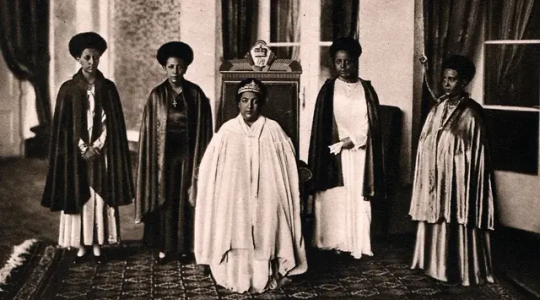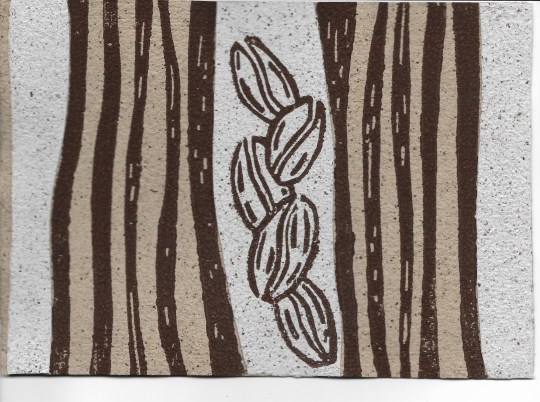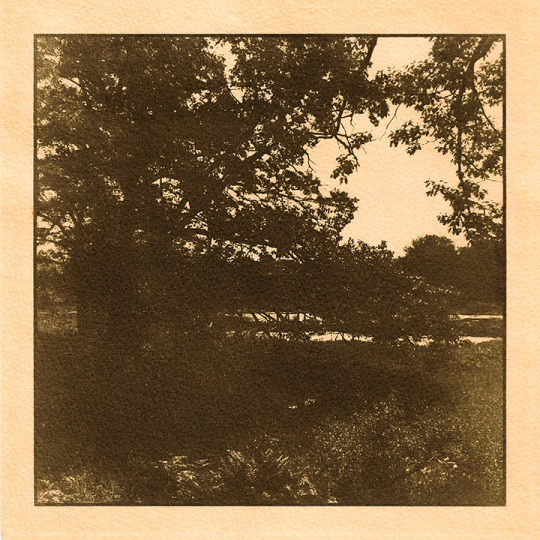#sidamo
Explore tagged Tumblr posts
Text

Headrest. Sidamo. Ethiopia, 20th Century CE.
Brooklyn Museum.
#sidamo#ethiopia#Ethiopian#art#culture#history#20th century#modern history#african history#brooklyn museum
14 notes
·
View notes
Text

Princess Tenagnework Haile Selassie, GBE (baptismal name: Fikirte Mariam; 12 January 1912 – 6 April 2003) was the eldest child of Emperor Haile Selassie and Empress Menen Asfaw.

Born in the city of Harar, Princess Tenagnework received her title upon her father's succession to the imperial throne in November 1930. Princess Tenagnework was first married to Ras Desta Damtew, a member of the prominent aristocratic Addisge clan. Ras Desta and Princess Tenagnework were the parents of two sons, Amha and Iskinder Desta (later Rear Admiral), and four daughters, Princesses Aida Desta, Seble Desta, Sophia Desta and Hirut Desta. Ras Desta Damtew was appointed Governor-General, first of Kaffa and Limu, and then of Sidamo.
In 1935, following the invasion of Ethiopia by Italy, the imperial family was forced to flee into exile at Fairfield House, Bath in England. However, Ras Desta remained behind to command the imperial forces fighting in the south of the country. Ras Desta was captured and summarily executed by the fascist forces. While in exile, Princess Tenagnework gave birth to Emebet Tsige Mariam (Mary) during a brief union with Ato Abebe Retta, who later served in ambassadorial and other roles in the post-war imperial government, and would eventually become president of the Imperial Senate after their separation.
#african#afrakan#kemetic dreams#africans#brownskin#afrakans#brown skin#african culture#Emebet Tsige Mariam#Abebe Retta#ethiopia#ta netjer#limu#sidamo#kaffa#tenagnework#Tenagnework Haile Selassie#italy#Fikirte Mariam#Menen Asfaw
16 notes
·
View notes
Text

3 notes
·
View notes
Text
Ethiopia's Coffee Treasure: A Guide to the Best Beans

Ethiopia, the birthplace of coffee, offers a diverse range of coffee beans renowned for their exceptional flavor. This article explores the best types of Ethiopian coffee and the factors that contribute to their unique taste.
From the floral notes of Yirgacheffe to the complex spice of Harar, Ethiopian coffee beans cater to various preferences. Discover the magic behind these beans and why they are prized by coffee connoisseurs worldwide.
For more information read the blog "https://medium.com/@mariamnuha123/discover-the-best-types-of-ethiopian-coffee-beans-07413945f218"
#EthiopianCoffee#CoffeeLovers#CoffeeBeans#Ethiopia#Yirgacheffe#Sidamo#Harar#Limu#Bensa#EthiopianCoffeeExporters#CoffeeCulture#CoffeeOrigin#SpecialtyCoffee#CoffeeJourney
0 notes
Audio
(Sidamo Soundsystem)
0 notes
Text
Dirre Sheikh Hussein , Also Known As The Makk’ah of Africa
Dirre Sheikh Hussein, situated in the Bale Zone of the Oromia Region in south-eastern Ethiopia, is a town steeped in rich history, spirituality, and folklore. This town, nestled at a longitude and latitude of 7°45′N 40°42′E and an elevation of 1386 meters above sea level, holds significant cultural and religious importance, primarily attributed to the tomb of the revered thirteenth century Somali…
#African architecture#Dirre Sheikh Hussein#east african architecture#east african history#oromia region#Oromo people#Sidamo people#The Makk’ah of Africa
0 notes
Text

Jonas - 2024 - #01 - Moka Sidamo (café d'éthiopie)
gravure sur bois - impression sur papier MIM (Made In Morvan) + découpage et collage avec deux papiers MIM
papier MIM- papiers d'emballage +- 99% + marc de café +- 1%
papier MIM - enveloppes recyclées +- 99% + marc de café +-1%
réalisation Jonas - 01 -2024
———————————————————————–
contacts et renseignements : [email protected]
————————————————————————
#Jonas#2024#papiers / impression & Cie#résister#projet artistique#gravure sur bois#papiers MIM#made in morvan#café#moka sidamo#Ethiopie#woodcut
0 notes
Text
241028 Wang Yibo Weibo update 💚
As the weather cools down, Cotti Coffee warm coffee is here.
Washed Yirgacheffe collides with sun-dried Sidamo coffee to bring a variety of high-quality warm coffees.
Each one is classic and each cup is warm.
Come and taste it together!
8 notes
·
View notes
Text
My latest in trawling thru semi-random comparative etymological dictionaries: Hudson (1989) on Highland East Cushitic. He gets together 767 reconstructions, a decent amount on a group of relatively little-studied languages. A nice chunk of vocabulary can be reconstructed especially for the major crop of the area, the enset tree (*weesa), its parts (e.g. *hoga 'leaf', *kʼaantʼe 'fibre', *kʼalima 'seed pod', *mareero 'pith', *waasa 'enset food') and tools for processing it (*meeta 'scraping board', *sissa 'bamboo scraper).
There surely has to be material among the reconstructions though that represent newer spread, most clearly the names of a few post-Columbian-exchange foodstuffs: *bakʼollo 'maize', *kʼaaria 'green chili' — same terms also e.g. in Amharic: bäqollo, qariya (Hudson kindly provides Amharic and Oromo equivalents copiously). (Note btw a vowel nativization rule appearing in these: Amharic a → HEC aa, but ä /ɐ/ → HEC a [a~ɐ~ə], as if undoing the common Ethiosemitic shift *aa *a > a ä.) Slightly suspicious are also a few names of trade items and cultural vocabulary / Wanderwörter like *gaanjibelo 'ginger', *loome 'lemon' (at least the latter could be again plausibly fairly recent loans from Amharic lome) but these could well have reached southern Ethiopia even already in antiquity.
In terms of root structure, interesting are two monoconsonantal roots: *r- 'thing, thingy, thingamajig' (segmentable from a diminutive *r-iččo and from Sidamo ra) and *y- 'to say'. Otherwise verb roots are the usual Cushitic *CV(C)C-, clusters limited to geminates and sonorant + obstruent; with several derivative extensions such as *-is- reflexive, *-aɗ- causative. *ɗ actually occurs almost solely in the last, I would suspect it's from one of the well-attested dental stops *t / *d / *tʼ with post-tonic lenition. Long vowels also seem to occur fairly freely in the root syllable with even several "superheavy" roots like *aanš- 'to wash', *feenkʼ- 'to shell legumes', *iibb- 'to be hot', *maass-aɗ- 'to bless', *uuntʼ- 'to beg'; *boowwa 'valley', *čʼeemma 'laziness', *doobbe 'nettle', *leemma 'bamboo', *mooyyee 'mortar'… A ban on CCC consonant clusters does seem to hold however, apparently demonstrated by *moočča ~ *mooyča 'prey animal', which probably comes from an earlier *moo- + the deminutive suffix *-iččV; resulting **mooyčča would have to be shortened in some way, either by degemination or by dropping *-y-.
In V2 and later positions there seems to be morphological conditioning of vowel length, cf. e.g. *arraab- 'to lick' : *arrab-o 'tongue'; *indidd- 'to shed tears' : *indiidd-o 'tear' (and not **arraabo, **indiddo). And as in these examples, also many basic nouns appear to be simple "thematizations" of verbs, similarly e.g. *buur- 'to anoint, smear', *buur-o 'butter'; *fool- 'to breathe', *fool-e 'breath'; *kʼiid- 'to cool', *kʼiid-a 'cold (of weather)'; *reh- 'to die', *reh-o 'death'. I don't actually see a ton of logic to what the "nominalizing vowel" ends up being though and maybe it's sometimes an original part of the stem, not a suffix. Quite a lot of unanalyzable nouns on the other hand are actually fairly long, e.g. *finitʼara 'splinter', *hurbaata 'dinner', *kʼorranda 'crow', *kʼurtʼumʔe 'fish', *tʼulunka '(finger)nail'.
Further phonologically interesting features include apparently a triple contrast between *Rˀ (glottalized resonants) and both *Rʔ and *ʔR clusters [edit: no, it's just very inconsistent transcription]; also ejective *pʼ is established even though plain *p is not (that has presumably become *f).
Lastly here's a some etyma I've found casually amusing:
*bob- 'to smell bad': take note, any Roberts planning on travelling to southern Ethiopia
*buna 'coffee': yes yes, this is the part of the world where you cannot assume 'coffee' will look anything like kafe
*mana 'man': second-best probably-coincidence in the data
*raar- 'to shout, scream' 🦖 [and looks like maybe a variant of *aar- 'to be angry?]
*sano 'nose': "clearly must be" cognate with PIE *nas- with metathesis :^>
*ufuuf- 'to blow on fire', oh yeah I've needed that verb sometimes
*waʔa 'water': Cushitic With British Characteristics
29 notes
·
View notes
Text

Slow Coffee Roasters
Price: $24 for each 250g bag.
After trying beans from Slow Coffee at D.O.SE. I decided to order some for home also! I got the Colombian Alben Santana (notes of 🍏 and 🍋) and the Ethiopian Sidamo (notes of blackberry and plum, and slightly darker than what I usually drink for filter)!
3 notes
·
View notes
Text



2023 - 24.July: Three Cyanotypes
I discovered some very old paper I'd prepared for making cyanotypes. Using recent images and hourlong exposures, I was able to use my "expired" paper. I toned the images by soaking them in very strong Ethiopian Sidamo coffee from Vermont's 802 Coffee Company. When it's time to tone cyanotypes, I use the finest ingredients!
11 notes
·
View notes
Note
Reply to coffee anon - Ethiopian as in Ethiopian yirgacheffe? Cuz I just discovered that blend and I'd mainline that shit
yirgacheffe ye, i also like guji, not sure about sidamo though
3 notes
·
View notes
Text

Birthplace of Coffee(Buna or pronounced Boo-na)
Kaffa (Amharic: ካፋ) was a province on the southwestern side of Ethiopia; its capital city was Bonga. Kaffa is bordered on the west by Sudan, on the northwest by Illubabor, on the north by Walega, on the northeast by Shewa, on the east by Sidamo, and on the southeast by Gamu-Gofa.

Kaffa people in southwest Ethiopia were the first to cultivate the coffee plant and recognize the energizing effect of the coffee beverage.

#african#afrakan#kemetic dreams#africans#brown skin#brownskin#afrakans#african culture#kaffa#bunna#coffee#coffee cup#coffee aesthetic#coffee addict#black coffee#coffee cake#coffee first#coffee beans#coffee lover#coffee photography#coffee please#coffeeaddict#coffeeshop#coffeelover#coffeetime#coffee time#hot coffee#morning coffee#cup of coffee#cafe
36 notes
·
View notes
Text
لماذا يُعد بن إثيوبيا من الأفضل في العالم؟ اكتشف السر
بن إثيوبيا.. موطن القهوة الأصلية ونكهتها الفريدة!
تُعد إثيوبيا مهد القهوة وأحد أفضل منتجي البن في العالم، حيث تنمو القهوة هناك طبيعيًا في بيئة مثالية تمنحها نكهات فريدة ومعقدة. يتميز البن الإثيوبي بإيحاءات الفواكه، الزهور، والعسل، مما يجعله خيارًا مفضلًا لعشاق بن اثيوبيا.
🌱 لماذا يُعتبر بن إثيوبيا مميزًا؟
1️⃣ الموطن الأصلي للقهوة
إثيوبيا هي مسقط رأس القهوة، حيث يُعتقد أن حبوب الأرابيكا نشأت هناك منذ مئات السنين.
يُزرع البن في مزارع طبيعية بدون استخدام مواد كيميائية، مما يحافظ على نكهته النقية والأصلية.
2️⃣ بيئة مثالية لنمو القهوة
تُزرع القهوة الإثيوبية على ارتفاعات تتراوح بين 1500 - 2200 متر، مما يمنحها نكهات غنية ومتنوعة.
تعتمد الزراعة على الأمطار والتربة البركانية الخصبة، مما يعزز جودة الحبوب.
3️⃣ نكهات فريدة ومتنوعة
يتميز بن إثيوبيا بإيحاءات الحمضيات، التوت، العنب، والزهور مثل الياسمين واللافندر.
مذاقه عادةً ناعم ومتوازن، مع حموضة مشرقة وحلاوة طبيعية.
4️⃣ طرق معالجة مختلفة تؤثر على الطعم
المعالجة المجففة (Natural Process): تمنح القهوة نكهات فاكهية وحلاوة طبيعية.
المعالجة المغسولة (Washed Process): تبرز الحمضية العالية والوضوح في الطعم.
5️⃣ أنواع مشهورة من القهوة الإثيوبية
بن سيدامو (Sidamo): نكهات فاكهية وزهرية مع قوام ناعم.
بن يرقاشيفي (Yirgacheffe): من أفضل أنواع القهوة المختصة، بإيحاءات زهرية وحمضية متوازنة.
بن هارار (Harrar): قهوة قوية بنكهات التوت والشوكولاتة الداكنة.
6️⃣ مثالية لمختلف طرق التحضير
V60، كيميكس، أيروبريس: لإبراز النكهات الفاكهية والزهرية.
الإسبريسو: لمحبي القهوة المركزة بحموضة مشرقة.
فرنش بريس: للحصول على قوام ممتلئ ونكهة قوية.
🎯 لماذا عليك تجربة بن إثيوبيا؟
أهمية بن إثيوبيا.. لماذا يعتبر الأفضل عالميًا؟
يحتل بن إثيوبيا مكانة خاصة في عالم القهوة، كونه الموطن الأصلي للبن العربي وأحد أفضل الأنواع في الأسواق العالمية. يتميز بجودته العالية ونكهاته الفريدة، مما يجعله عنصرًا أساسيًا لعشاق القهوة المختصة.
🌱 🔹 1. إثيوبيا.. مهد القهوة الأصلية
تعتبر إثيوبيا المصدر الأول للقهوة العربية (أرابيكا)، حيث نشأت هناك منذ مئات السنين.
تمتلك إثيوبيا أنواعًا نادرة من البن لا توجد في أي مكان آخر في العالم.
🔥 🔹 2. نكهات طبيعية متميزة
يتميز بن إثيوبيا بإيحاءات الفواكه، الأزهار، العسل، والتوابل، مما يجعله تجربة فريدة لعشاق القهوة.
تختلف النكهات باختلاف المناطق، مثل:
يرقاشيفي (Yirgacheffe): نكهات زهرية وفاكهية.
سيدامو (Sidamo): توازن رائع بين الحلاوة والحمضية.
هارار (Harrar): طعم قوي مع إيحاءات الشوكولاتة والتوت.
🌍 🔹 3. أهمية اقتصادية لإثيوبيا
تُعتبر القهوة العمود الفقري للاقتصاد الإثيوبي، حيث تشكل أكثر من 60% من صادرات البلاد.
تدعم صناعة البن ملايين المزارعين الذين يعملون في زراعة البن وتجهيزه بطرق تقليدية.
⚡ 🔹 4. زراعة طبيعية ومستدامة
يزرع البن الإثيوبي في بيئة طبيعية بدون مواد كيميائية، مما يجعله خيارًا صحيًا ونقي��ا.
تعتمد مزارع القهوة على الأمطار والتربة البركانية الغنية، مما يعزز جودة المحصول.
🏆 🔹 5. تصنيف عالمي من بين الأفضل
يصنف بن إثيوبيا باستمرار ضمن أفضل أنواع القهوة المختصة عالميًا.
تُستخدم حبوبه في أشهر محامص القهوة العالمية بفضل نكهتها الفريدة وجودتها العالية.
🎯 🔹 6. مثالي لمختلف طرق التحضير
يتناسب مع القهوة المقطرة (V60، كيميكس) لإبراز النكهات الفاكهية والزهرية.
يستخدم في الإسبريسو للحصول على نكهة مركزة ومتوازنة.
مناسب لـ الفرنش بريس للحصول على قوام ممتلئ وطعم غني.

0 notes
Text
Top Ethiopian Coffee Varieties for Export Market

Ethiopia, the birthplace of coffee, is renowned for its diverse and high-quality coffee varieties. The country’s unique climate, rich soil, and traditional processing methods contribute to the distinct flavors that set Ethiopian coffee apart in the global market. Coffee export in Ethiopia plays a significant role in the nation’s economy, with various regions producing beans that are sought after by coffee lovers worldwide. In this article, we will explore the top Ethiopian coffee varieties that dominate the export market and why they are so highly valued.
1. Sidamo Coffee
Sidamo coffee is one of Ethiopia’s most famous and widely exported varieties. Grown in the southern part of the country, it is known for its medium acidity, bright citrus flavors, and rich body. Sidamo beans are often processed using the washed (wet) method, which enhances their clean and crisp taste. Due to its balanced profile and smooth finish, Sidamo coffee is a favorite among specialty coffee buyers worldwide.
2. Yirgacheffe Coffee
Yirgacheffe, another well-known coffee variety from Ethiopia, is often considered one of the best in the world. This coffee is cultivated at high altitudes, which helps develop its floral aroma and complex flavors. Yirgacheffe coffee is prized for its notes of jasmine, bergamot, and citrus, making it a preferred choice for those who appreciate bright and tea-like coffees. The washed processing method further enhances its clarity and fruity undertones.
3. Harrar Coffee
Harrar coffee, grown in the eastern highlands of Ethiopia, is famous for its bold and wine-like characteristics. This variety is typically sun-dried using the natural (dry) processing method, which allows the coffee cherries to absorb more sweetness from the fruit. The result is a coffee with strong berry notes, chocolate undertones, and a full-bodied taste. Harrar coffee is often used in espresso blends due to its intense and complex flavor profile.
4. Guji Coffee
Guji coffee, grown in the Oromia region, has gained immense popularity in recent years. This variety is known for its vibrant fruitiness, floral aroma, and rich sweetness. Guji coffee can be processed using either the washed or natural method, leading to variations in taste. The natural-processed Guji coffee exhibits deep red berry notes, while the washed version offers a cleaner and brighter flavor.
5. Limu Coffee
Limu coffee, grown in the western part of Ethiopia, is known for its balanced acidity, floral fragrance, and slightly spicy notes. This variety is often wet-processed, giving it a clean cup profile with hints of caramel and citrus. Limu coffee is valued for its consistency and smooth taste, making it a preferred option for roasters looking for a well-rounded Ethiopian coffee.
Conclusion
Ethiopia’s coffee export industry thrives due to the exceptional quality and variety of its beans. Sidamo, Yirgacheffe, Harrar, Guji, and Limu are among the top Ethiopian coffee varieties that continue to dominate the global market. These coffees not only represent Ethiopia’s rich coffee heritage but also cater to a wide range of taste preferences. As the demand for specialty coffee grows, Ethiopian coffee remains a leading choice for coffee enthusiasts worldwide.
#CoffeeExportInEthiopia#EthiopianCoffee#SidamoCoffee#YirgacheffeCoffee#HarrarCoffee#GujiCoffee#LimuCoffee#SpecialtyCoffee#OrganicCoffee#AfricanCoffee
0 notes
Text
Yemeni Coffee Beans vs. Other Single-Origin Coffees: A Flavor Comparison
When it comes to single-origin coffee, each region offers a unique flavor profile influenced by its climate, soil, altitude, and traditional farming practices. Among the world’s most coveted coffee origins, Yemeni coffee beans stand out for their distinctive, complex flavors and rich history. But how do they compare to other single-origin coffees from regions like Ethiopia, Colombia, or Guatemala?
In this article, we’ll dive into the flavor profiles of Yemeni coffee beans versus other popular single-origin coffees. Whether you’re a coffee enthusiast or new to specialty coffee, this comparison will help you understand what makes Yemeni coffee truly unique.
What Is Single-Origin Coffee?

Single-origin coffee refers to coffee sourced from a specific region, farm, or country. Unlike coffee blends, which mix beans from multiple origins to create a balanced flavor, single-origin coffee allows you to experience the pure essence of one region’s terroir—including its soil composition, altitude, and climate.
Single-origin coffees are prized for their authenticity, traceability, and complex flavor profiles. They often showcase bright acidity, unique fruit notes, and distinct aromas that reflect the characteristics of their growing region.
Yemeni Coffee Beans: A Flavor Profile Like No Other

Yemen is one of the oldest coffee-producing regions in the world, with coffee cultivation dating back to the 15th century. Its coffee-growing regions, such as Haraz, Ismaili, and Bani Matar, are located in high-altitude, arid mountain terraces, where coffee is grown using traditional methods without synthetic chemicals.
Flavor Profile of Yemeni Coffee Beans:
Rich Chocolate Notes: A signature characteristic, offering deep cocoa undertones.
Dried Fruit Sweetness: Natural sun-drying enhances flavors of raisins, dates, and figs.
Spicy Undertones: Hints of cinnamon, cardamom, and subtle earthy spices.
Wine-Like Acidity: A complex, balanced acidity that adds depth without sharpness.
Full-Bodied Texture: A dense, syrupy mouthfeel that lingers on the palate.
If you’re looking to experience the bold, authentic taste of Yemen, try Yemeni Kholani Coffee Capsules, crafted from 100% single-origin Yemeni coffee beans with rich, natural flavors.
Comparing Yemeni Coffee to Other Single-Origin Coffees

1. Yemeni Coffee vs. Ethiopian Coffee
Ethiopian coffee, particularly from regions like Yirgacheffe and Sidamo, is often considered Yemen’s closest rival due to its historical and geographical proximity.
Ethiopian Coffee Flavor Profile:
Floral notes like jasmine and lavender
Bright, citrusy acidity
Light body with tea-like clarity
Fruity notes of blueberry and bergamot
Key Difference: While Ethiopian coffee is known for its floral and fruity brightness, Yemeni coffee leans toward richer, darker flavors with chocolate, dried fruit, and spice undertones. Ethiopian coffees are often lighter, while Yemeni coffee is full-bodied and bold.
2. Yemeni Coffee vs. Colombian Coffee
Colombian coffee is globally recognized for its smooth, balanced profile, grown in the lush Andean mountains.
Colombian Coffee Flavor Profile:
Medium body with a smooth, creamy texture
Bright, citrus-like acidity
Notes of caramel, red berries, and nutty undertones
Clean, sweet finish
Key Difference: Colombian coffee offers a clean, bright, and approachable flavor, perfect for everyday drinkers. In contrast, Yemeni coffee is more intense, with earthy, wine-like depth and a complex, layered taste that appeals to those seeking bold, adventurous flavors.
3. Yemeni Coffee vs. Guatemalan Coffee
Guatemalan coffee, particularly from Antigua, is known for its rich, full-bodied profile with vibrant acidity.
Guatemalan Coffee Flavor Profile:
Strong chocolate and nutty flavors
Bright, tangy acidity
Notes of toffee, citrus, and mild smokiness
Velvety body with a smooth finish
Key Difference: Both Yemeni and Guatemalan coffees share chocolatey notes, but Yemeni coffee has an added dimension of spice and dried fruit, giving it a more exotic, complex profile. Guatemalan coffee is often cleaner, while Yemeni coffee feels earthier and richer.
4. Yemeni Coffee vs. Kenyan Coffee
Kenyan coffee is famous for its bold, bright acidity and vibrant fruitiness.
Kenyan Coffee Flavor Profile:
High, wine-like acidity
Juicy, berry-forward notes (blackcurrant, grapefruit)
Medium body with a crisp, clean finish
Refreshing, tangy aftertaste
Key Difference: While Kenyan coffee is celebrated for its bright, zesty fruitiness, Yemeni coffee offers a deeper, darker flavor with spiced, chocolatey notes and dried fruit sweetness. Kenyan coffee is sharper, whereas Yemeni coffee has a smoother, more balanced acidity.
Why Yemeni Coffee Stands Out Among Single-Origin Coffees

Ancient Coffee Heritage: Yemen is where coffee was first cultivated commercially, giving it a deep cultural and historical significance.
Traditional Farming Methods: Coffee is grown on terraced mountain farms, using centuries-old techniques without synthetic fertilizers.
Natural Sun-Drying Process: Beans are naturally dried with the fruit intact, enhancing sweetness and complexity.
Rare & Limited Production: Yemen’s coffee is grown in small, family-owned farms, making it rare and highly prized in the specialty coffee world.
Unmatched Flavor Complexity: The combination of earthy, chocolatey, fruity, and spicy notes creates a cup unlike any other coffee in the world.
Experience the bold, authentic taste of Yemeni coffee with Yemeni Kholani Coffee Capsules—crafted from 100% single-origin Yemeni coffee beans, offering a rich, complex flavor that lingers with every sip.
Final Thoughts
While each single-origin coffee offers its own unique flavor journey, Yemeni coffee beans stand out for their bold, complex, and rich profile. The combination of ancient farming traditions, high-altitude cultivation, and natural processing methods creates a coffee experience that’s truly one of a kind.
If you’re ready to explore the authentic taste of Yemen, try Yemeni Kholani Coffee Capsules for a bold, flavorful cup that reflects Yemen’s rich coffee heritage.
0 notes